FUTURE WORLD 2067
COMPUTER SCIENCE
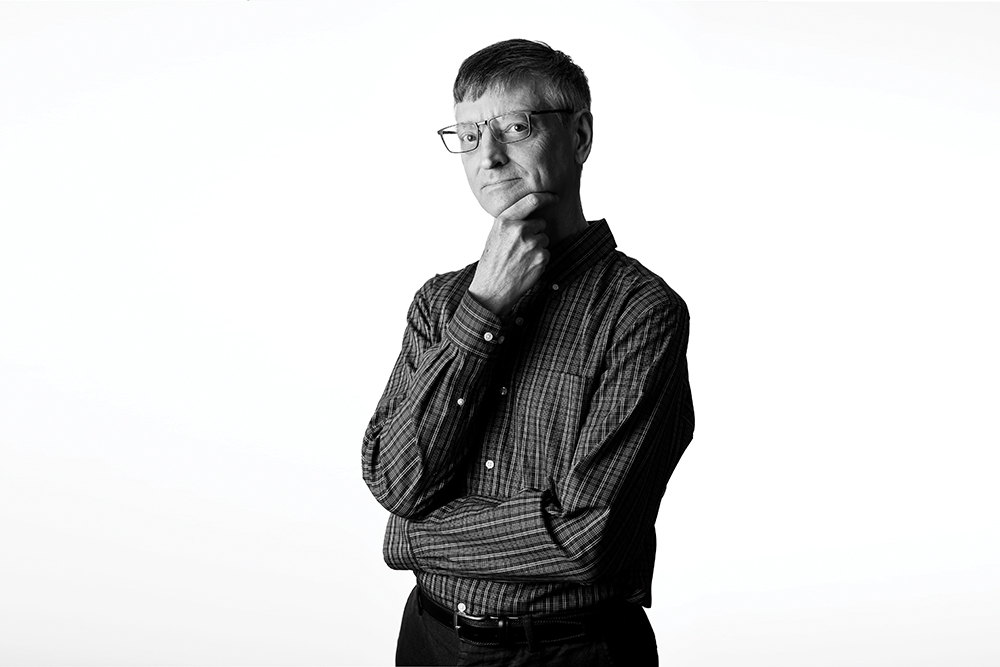
WILLIAM GROPP director of the National Center for Supercomputing Applications, Thomas M. Siebel Chair in the Dept. of Computer Science, Grainger Distinguished Chair in Engineering
Dr. Gropp’s research focuses on using high-performance computing to solve complex problems, and he’s played a key role in developing software for that purpose. His achievements include pioneering a message-passing standard that facilitates parallel computing—when multiple processors work simultaneously on the same problem. (Image by Fred Zwicky)
Computers will become even more ubiquitous
We’re all terrible at predicting the future. For many years, there was a mathematically exponential increase in computing performance—we were increasing the speed of the raw components by a factor of two every 18 months.
But in the early 2000s, everything collapsed. Individual components could perform 2 billion to 3 billion operations per second in 2005, and it’s about 2 billion to 3 billion operations per second in 2023. This is very common with technologies. They go through this amazing growth and then flatten out.
By 2067, we’ll be confronted with the fact that we can’t just rely on computing elements to get faster. Instead, we’ll have to continue learning how to make things more productive, more parallel—able to do more things at one time.
Another rising concern in computing is power consumption and its impact on the Earth’s climate. To deal with these engineering challenges, we’ll have to develop more specialized technologies.
Because of that, a modern computer in 2067 will probably not look anything like our supercomputers now. The current machines have effectively one kind of computing element, but hundreds of thousands of those elements. By 2067, machines will be more complex collections of both special- and general-purpose computing elements. That’s the only way to get the computing speeds and power efficiencies we’ll need to continue to solve harder and harder problems.
We’re in the midst of a so-called AI revolution, but current technologies are more like imitation intelligence than artificial intelligence.
Simultaneously, we’ll continue making that complexity easy enough so everybody can take advantage of it. Think of your car—your car is complex and complicated, but you don’t have any trouble driving it.
Computing will become even more a part of the infrastructure, the way phones have. Your phone today is more powerful in every way than the supercomputer that I worked on as a graduate student. Even your toaster probably has a small computer in it. Computing will continue to advance as a tool that’s everywhere, part of everything, to the point where we don’t really think about it consciously.
Then there’s artificial intelligence. We’re in the midst of a so-called AI revolution, but current technologies are more like imitation intelligence than artificial intelligence. Large language models like ChatGPT mimic intelligence by drawing on existing data to produce, in a statistical fashion, text that looks intelligent.
That doesn’t mean it’s not useful, but it does have limits. For example, it “hallucinates”—it manufactures facts.
For true AI, we need systems that comprehend data. A lot of early AI research looked at questions such as, how do humans build representations, how do we reason? What we may see at some point is taking what we’ve learned from the machine learning side, which gives you a lot of power, and merging that with other ways of organizing and understanding—more like the way our own brains work. That could lead to actual artificial intelligence, not just an imitation.
I also expect people to come up with other disruptive ideas that will become part of the way we live. One reason we’re bad at predicting is that we tend to extrapolate from where we are now, and that’s never what happens. When I was a kid, we predicted flying cars. But the things that have been really disruptive—like social media—nobody expected. So, what will happen? I think we will all be surprised.
CLIMATE CHANGE AND AGRICULTURE
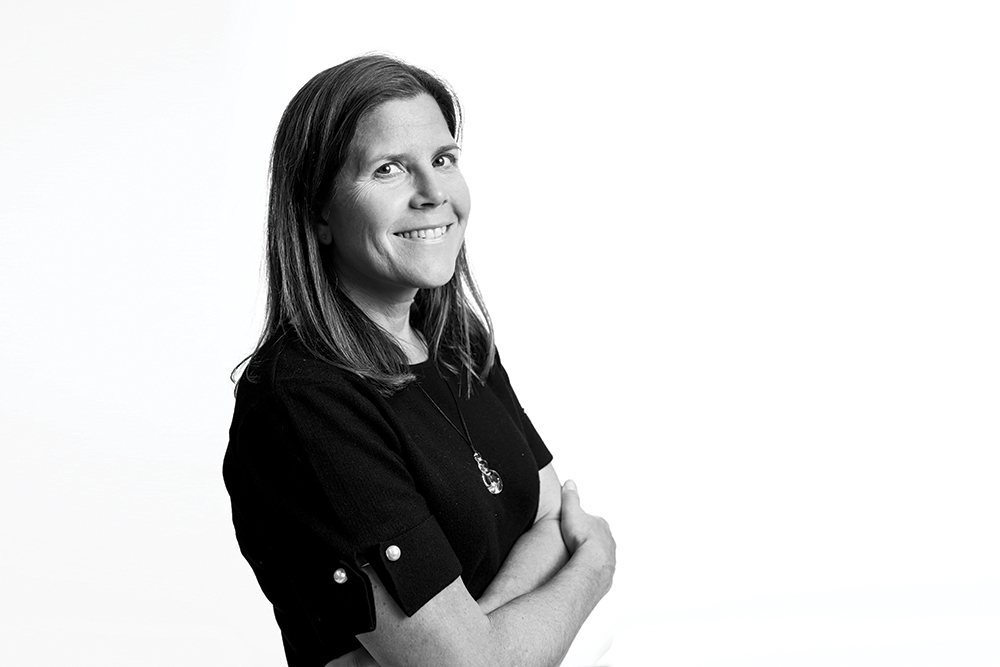
LISA AINSWORTH, PHD ’03 ACES, research leader of the Global Change and Photosynthesis Research Unit, adjunct professor of Plant Biology and Crop Sciences
Using physiological, biochemical and genomic tools, Dr. Ainsworth studies how plants respond to climate change. To this end, she directs research at SoyFACE, an innovative facility in Urbana where crops grow in atmospheric and soil conditions altered to simulate those expected in 2050. (Image by Fred Zwicky)
Hardier plants, new technologies turn farming from pollution to solution
I specifically study how crops respond to changes in the atmospheric composition anticipated
50 years from now.
When I imagine the future, I think about warmer climates, the higher carbon dioxide concentrations causing them and the need for more water for plants to use because of those factors. People’s lives are already affected by climate change—evidenced by the wildfires, dust storms and heat waves of summer 2023. That will only continue, and more intense extremes are yet to come.
Almost 20 percent of greenhouse gases come from animal and plant agriculture, which we depend on for food, fiber and fuel. We certainly can’t live without agriculture. The research that encourages me most is investigating how to use agriculture as a solution rather than just a contributor to climate change.
Of the Earth’s terrestrial surface, 12 percent is covered by croplands, one-third is covered by deserts, and the rest are covered by forests, natural lands and urban areas. When I look to the future, I hope there won’t be an expansion of croplands, but that existing agricultural lands will be more sustainable and used to actually slow or mitigate climate change.
The strategies for a sustainable agricultural future are very broad. Some are based on plant genetics and physiology. Some scientists are improving photosynthesis in crops, while other scientists are working to increase high temperature tolerance of our crops, and others are enabling more production with less water. In my lab, we’re investigating atmospheric adaptation, creating crops adapted to higher CO2 concentrations and more tolerant of ozone pollution.
The reality is, it’s hard to be a human enjoying our current quality of life and not have a big carbon footprint.
Other groups at Illinois are using plants to obtain and engineer raw materials for fuels we need—for instance, producing oil in grasses like sorghum or miscanthus. With that approach, we have a bioproduct that we can turn into all manner of other things, including jet fuel, so we have a sustainable way to power the future.
We can also consider our agricultural landscape. Are we making good choices about where we’re planting specific crops, or are there more economically and environmentally sustainable ways to manage our landscapes? Perhaps in 50 years, Illinois will have a landscape with a greater diversity of crops, reconstructed prairies and forests that better address the dual demands for agricultural products and climate mitigation.
If there were an easy solution to climate change, we would have found it. The reality is, it’s hard to be a human enjoying our current quality of life and not have a big carbon footprint. Lots of solutions in all sectors could each contribute a little bit to more efficient practices, supporting our lifestyles.
When I look to 2067, the most important thing I’m doing now is training students. I hope my research will be impactful—that the genes we identify to adapt crops to withstand ozone pollution and higher CO2, and the strategies we’re testing for mitigating climate change, will be successful. But I don’t know if those are the ones that will make the biggest difference. Having a group of people who are motivated to tackle this major challenge is the legacy that will last the longest.
MEDIA
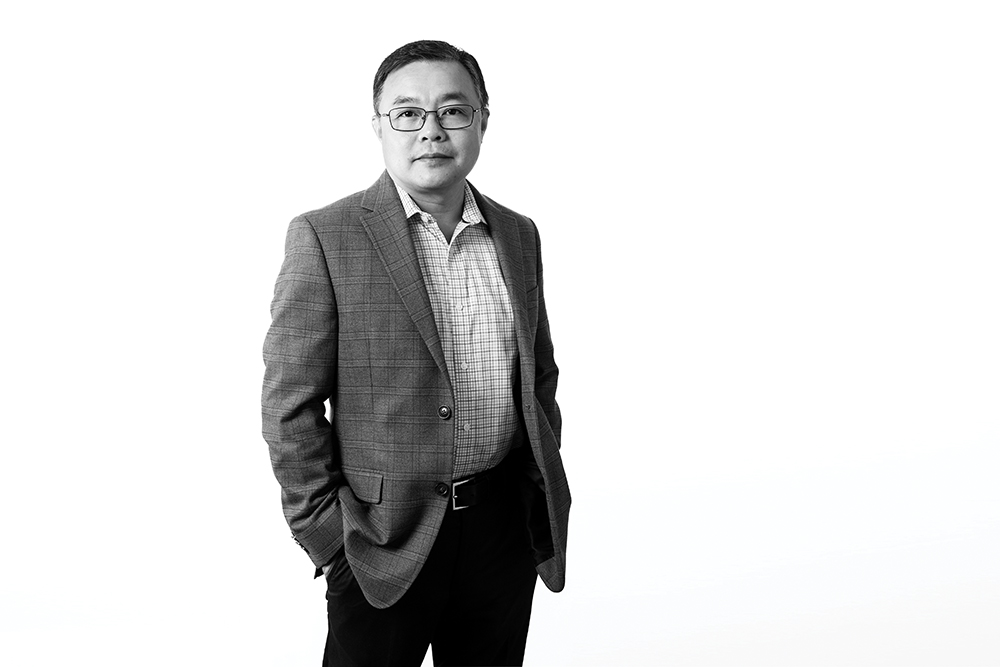
MIKE ZHENGYU YAO, professor of digital media, director of the Institute of Communications Research
Dr. Yao’s training as a media psychologist informs his research on the way media technologies impact the way humans think, act and feel. He’s an associate editor at the Journal of Computer-Mediated Communication and an editorial board member of the Journal of Media Psychology and Communication Methods and Measures. (Image by Fred Zwicky)
Seamless technologies will unlock our creative potential
Not long ago, we had to go to a designated place or specific device to have access to knowledge—say, a library or a desktop computer connected to the internet. Now, we carry a whole world of knowledge and our entire social network in our pockets and on our wrists.
But still, the medium has remained front and center—whether it’s a piece of paper, a radio or a screen. In the future, I see the disappearance of that mediation. The knowledge will be there, presented to us in a way that’s accessible and natural. Why do we need TVs? Any wall or window could be a projection space that we could interact with by touching it.
My hope is that this will return us to a more human experience. At the end of the day, using a computer is not natural. Typing on a keyboard is an arbitrary way to interact with computing devices. More seamless technologies will allow many more people to have access to information, even if they didn’t learn how to type or aren’t physically able to type.
As this happens, the concept of “making a living” will need to be reevaluated. Currently, our economic system runs on human productivity. We place a lot of value on certain kinds of job functions. You spend 20 or 30 years to become good at something. For the rest of your life, you perform this one task to contribute to society.
I hope that, with technology, we can start to free our time from doing repetitive tasks. And if we don’t have to spend a lot of time learning skills, we can explore our individual creativity. We’ll become the best and most powerful versions of ourselves.
The system is set up in a way that knowledge transfer, innovation and publication have been North American- and European-centric.
For example, maybe my parents didn’t send me to study a musical instrument. But that doesn’t mean that I am not artistic, that I don’t hear beautiful harmonies in my head. Soon, it will be easier for me to express myself without having to learn to write music.
Another example is with language. There are many intelligent people who didn’t go to school or learn to write in a way that society deems beautiful. Often, this is due to inequities. Plus, many good ideas never see the light of day because they aren’t published in English. The system is set up in a way that knowledge transfer, innovation and publication have been North American- and European-centric.
It’s personal for me, because as a first-generation immigrant, English is not my native language. Now, because artificial intelligence makes it easier to translate, language is less of an issue. We’re starting to see a more global form of scholarship. How much more knowledge will soon be available to us because innovation will now come from all over the world?
Language and social structures have been artificial barriers. But I see potential in technology to remove those barriers, to make our world more inclusive for all walks of life. This is going to lead to an explosion of development and progress.
ROBOTICS
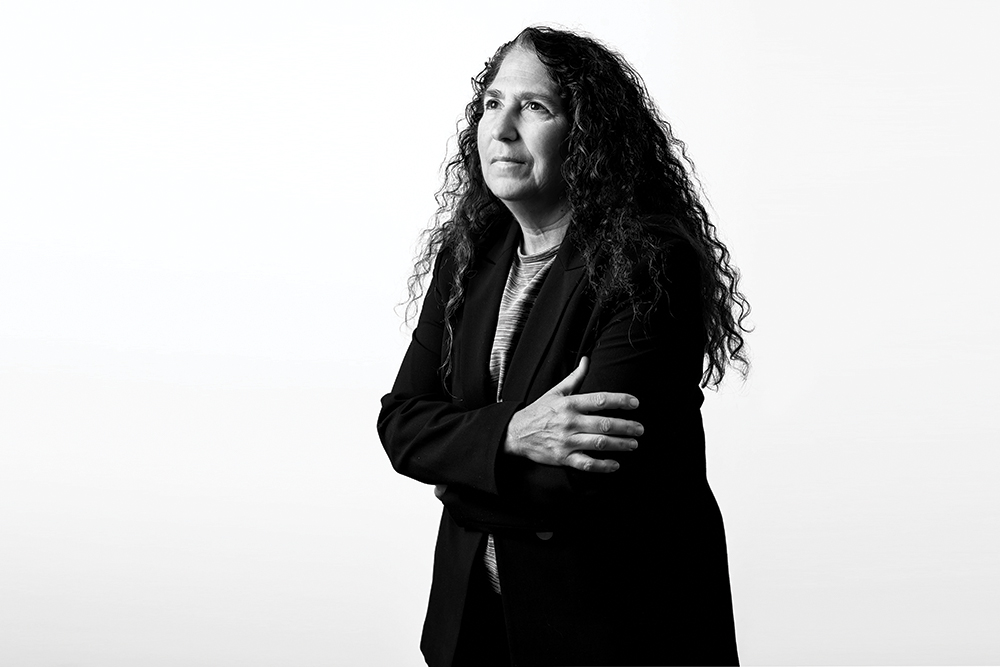
NANCY AMATO, PHD ’95 ENG, head of the Computer Science Dept., and Abel Bliss Professor of Engineering
Dr. Amato is the first woman to lead the U of I Computer Science Dept. She’s a worldwide authority on motion planning in robotics, parallel algorithms and bio-informatics, and has graduated 25 Ph.D. students. Dr. Amato is also co-director of Mind in Vitro: Computing with Living Neurons, a multi-university National Science Foundation-funded project. (Image by Fred Zwicky)
Robotic assistants will come to our aid throughout life
Right now, we’re having this huge disruption with large learning models. Those systems can process huge amounts of text, but they can’t walk across the room. By 2067, we are going to have a similar level of disruption with embodied systems. It’s going to be incredible, what will happen. We will have robots that are essentially personal assistants throughout life.
Computers already help kids learn. But we also know that if you have a physical presence there, it can be more helpful. So from childhood, the robot could play with kids and teach them simple tasks, like a personal tutor.
Throughout your life, it could do some of your repetitive tasks or remind you to do things. Along the way, the robot could also store memories, becoming the repository of all the photos and videos you take. When you’re older, it could allow you to stay independent longer by helping with physical tasks.
We’ll also have robots doing dangerous tasks. For example, after the nuclear disaster in Fukushima, Japan, they used robots for the clean-up. We’ll send robots into space. Ideally, they’d make some autonomous decisions while also getting remote direction from us. If so, they’re really going to extend the things we can do.
What will all these robots look like? We need more research on that. There’s a phenomenon called the uncanny valley. We like robots that resemble us somewhat, but if they’re too much like us, we feel uneasy. We don’t want them to be confused with people—they’re not part of our social circle, they’re not our friends. It may even be that at different stages of our lives, our robot assistants will look different.
We’re making advances, but we don’t have robots that are very reliable “in the wild,” such as being able to walk around the office.
That’s one challenge to overcome. There are many others. My work relates to what is generally called task and motion planning. That involves getting a robot to move from, say, my office to another office on another floor of the building. It must find a safe path, and it might need to open doors or ask someone to call the elevator.
Right now, we’re struggling to have robots work properly even in well-designed factory settings. We’re making advances, but we don’t have robots that are very reliable “in the wild,” such as being able to walk around the office. Their perception is much better than it used to be, but in environments where things change a lot, robots face many computational challenges.
Equitable access to these technologies is also a big concern. And of course, there are huge policy and privacy implications to all this. It’s our responsibility to think about those issues when we’re developing these technologies.
Engineers and computer scientists can’t solve those problems by themselves; it’s not our expertise. But we need to work with others—ethicists, psychologists and social scientists—early on. We also need diversity in all these fields, so we can bring different perspectives to these questions. We can’t come up with the right answers unless everyone’s participating.
KINESIOLOGY

MARNI BOPPART, professor, director of Strategic Initiatives for Kinesiology and Community Health
Dr. Boppart’s work has long taken her between the lab and the skies—she began her career in the U.S. Air Force, where she was an officer and aerospace physiologist. Boppart has received research support from NASA and the National Institutes of Health and holds a joint appointment at the Beckman Institute for Advanced Science and Technology. (Image by Fred Zwicky)
An “exercise pill” will extend our healthy years
Thanks to medical advances, we’re living longer than ever, but many people aren’t independent or healthy during the last decade of life. The goal right now is to increase healthspan—the ability to live as healthy as possible, for as long as possible. I believe in the next 50 years, our ability to increase healthspan will match the increase in lifespan, in part by better understanding exercise.
Humans have observed for centuries that physical activity is essential for maintaining health and preventing degenerative diseases, such as diabetes, heart disease and dementia. Yet, we still know very little about the molecular and cellular mechanisms responsible for these benefits.
I devote half of my research time to studying the structural and functional changes in skeletal muscle following exercise. This includes the release of materials from muscle—proteins, RNA, antioxidants—that ensure our whole bodies respond positively to exercise.
We do this by having mice or humans work out, then collecting their blood afterward. Within the blood, there are small, lipid-based nanoparticles known as extracellular vesicles, or EVs, that are believed to carry cellular cargo. We’re trying to capture these EVs and look at what’s within them, then determine if those compounds stimulate the health benefits of exercise.
The second half of my research is spent developing new therapies to recover muscle mass and health after periods of disuse. After we isolate the potentially beneficial factors within EVs, we place them in nanosized materials and deliver them back to mice or humans. Then, we test whether they help rebuild muscle or grow new blood vessels, which is also important for tissue health.
Our work will be highly relevant over the next 50 years as the older adult population continues to increase exponentially worldwide.
We are essentially designing an “exercise pill.” It won’t be a pill, exactly—if there are proteins and peptides involved, they would degrade in the stomach—but a therapy that would be injected or implanted.
A common scenario is an older adult who falls and fractures a bone. This can result in several days of bed rest or casting, which can worsen skeletal muscle loss. Sadly, this can turn into a rapid, downward spiral of a decline in health, a physical disability, admission to a nursing home, and in many cases, an early death.
If we’re successful, we could jumpstart these individuals and increase their ability to engage in natural movement so that they can rehabilitate. The eventual treatment would be a combination therapy of our exercise pill and traditional physical therapy.
Our work will be highly relevant over the next 50 years as the older adult population continues to increase exponentially worldwide. It will also be used to support the NASA Artemis program, which hopes to send astronauts to the Moon and Mars.
This piece of the puzzle—supporting human exploration in space—will require creativity. There is a significant, rapid deterioration in microgravity. You’re taking away all the mechanical cues to maintain muscle and other tissues. To develop a pill to fully preserve them in that environment is going to be very difficult.
Whether we’re on Earth or in outer space, we all want a long, healthy life. I think we’ll make significant progress toward that goal by 2067.
MEDICINE
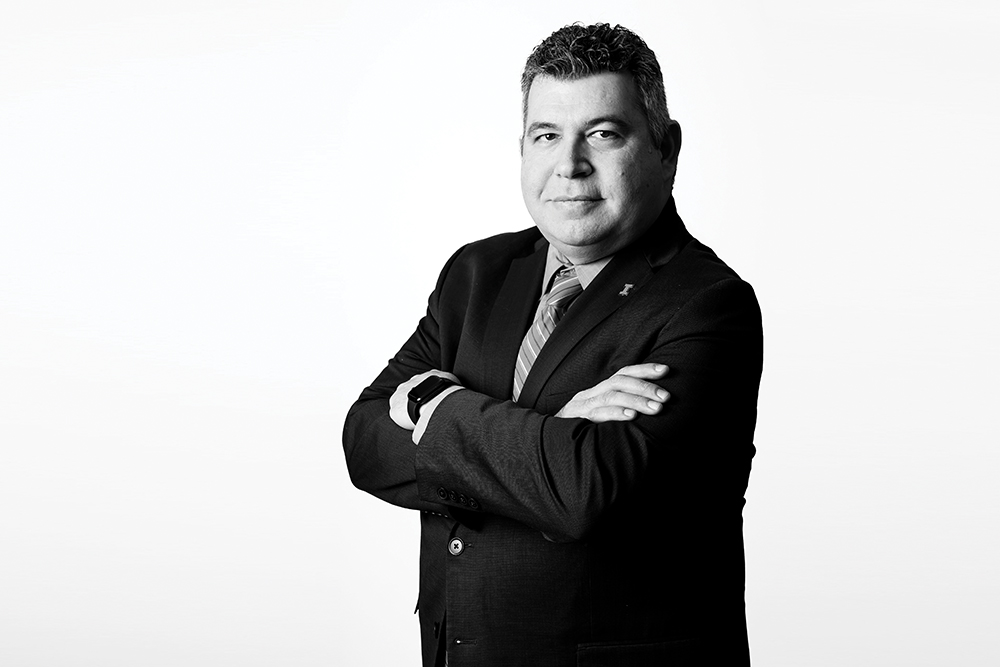
MARK COHEN, dean of the Carle Illinois College of Medicine, and senior vice president and chief academic officer for Carle Health
Dr. Cohen, a physician-engineer who practices as a surgical oncologist and endocrine surgeon, came to Carle Illinois from the University of Michigan in May 2022. His research interests include engineering tissue to create organs from fat stem cells; creating new drug delivery methods; and improving telemedicine through mixed reality technologies. (Image by Fred Zwicky)
You’ll get treatment tailored to you—in the comfort of your own home
Precision medicine, personalized medicine and tissue engineering are going to evolve incredibly in the next 20 to 50 years.
We’ll be able to recreate organs and regenerate parts of the body. We’ll do that all in the lab and engineer it, so you won’t need to be on immunosuppressive drugs for the rest of your life. We’ll also be able to diagnose diseases genetically years before they ever manifest and give you treatments, so you never get sick.
Around drugs and therapies, we’re going to have a much wider selection, precise for each person. We’ll tailor drugs to treat your tumor in exactly the way it develops or cure your disease in a way that’s unique for what you need.
We’re also doing a lot of great research around the future of medicine, using augmented reality and virtual reality. Virtual reality is where you put on a headset and everything you see is within a virtual world. Augmented reality, meanwhile, uses holographic images, which are added into the real world, bringing in more data and visuals.
We’re using these tools to teach procedures and skills to medical students. They’re also enabling us to collaborate across great distances. We can use telemedicine more effectively and help clinicians make better decisions.
In the future, you’ll be in the comfort of your own home and a physician of any specialty will come into your environment as a holographic image. They’ll go through your history and symptoms, and make your diagnosis. You’ll be able to have testing done without going to a hospital.
People might use home-based devices or tools that can be worn on their wrists to get updates on their health.
As technology breaks down physical and social barriers, access to care will improve. For example, people in remote rural or underserved areas will get quality care in their homes. Experts from any-where in the world will come to their bedside.
We’ll also have more opportunities to provide education and monitoring remotely. People might use home-based devices or tools that can be worn on their wrists to get updates on their health. You’ll be a full participant in your health journey.
As we improve access and treat disease earlier, people will live longer. Of course, new problems will come up. But we learned from the pandemic that we can be more collaborative and nimbler when we need to.
The biggest challenges involve bringing industry, government and academia together more easily. We need to learn how to expand solutions from one area to another, decrease costs, and create more access to important treatments and therapies. All of that will be essential to achieve this new, improved future of health care.
In the College of Medicine, we’re leading the charge to collaboratively solve bigger problems in health. We’re creating a new Global Consortium of Innovation and Engineering in Medicine this year, which is bringing together over 30 medical schools, companies, and government agencies to create a new global network that will advance medical education and accelerate medical innovations to address global health challenges more effectively. This will move solutions developed here in Urbana-Champaign to the world.
We also have a unique opportunity to train more physician-innovators, teaching them how to keep the patient at the center of their efforts as they bring technology and innovation into compassionate care.

